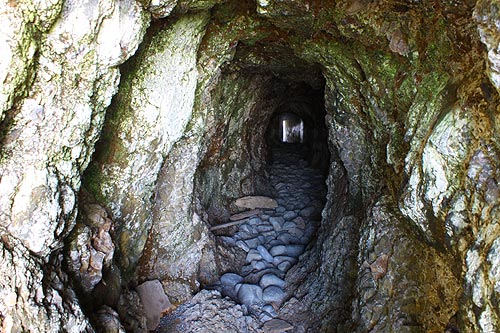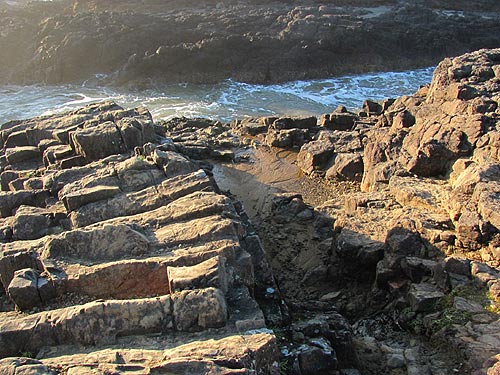 |
Rocky Mysteries of the Oregon Coast
Published 01/18/2013

(Oregon Coast) – They are often hiding in plain sight. Other times, you've got to go exploring a bit to find these off-kilter treasures. You may not recognize what they are at first, or maybe you do, and you're surprised to notice these unique finds for the first time.
Often, the most interesting things about the Oregon coast are its most obscure. These delightful oddities fit both criteria of such surprises or discoveries. They impart some striking history about the region, sometimes going back millions and millions of years. And they are bound to make you scratch your head just a little bit.
 Tunnel Cave at Oceanside (above).
Tunnel Cave at Oceanside (above).
The tunnel at Maxwell Point has proven a fascinating bit of mystery for generations coming here – and then it disappeared for a decade or two until the mid-80's. Oceanside's tunnel was blasted into Maxwell Point here early in the 20th century by a family of would-be resort makers called the Rosenbergs (their name still adorns some local businesses in Tillamook County). Things didn’t turn out as prosperous as they might have planned, but the tunnel is a magnificent little sojourn that’s part nature and history walk and part fun house thrill attraction.
It's essentially one big long cave, which heads to what is called Tunnel Beach (or some have called it “Star Trek Beach” in the last decade).
What's most interesting about this area is that early in the resort's history, around the 20's and 30's, there was a suspension bridge going around Maxwell Point, and another going around the next rocky dead-end. This went to a beach called Lost Boy Beach, complete with a cave called Lost Boy Cave – for obvious reasons.
You can't really get to that beach these days, but the pristine “Star Trek Beach” is readily accessible via the tunnel, although you have to heed the warnings about falling rocks during rainy weather and stay clear. Tidal conditions sometimes don't let you get near it either. So be extremely cautious. More on Oceanside.

Mysterious Steps of the Central Coast (Strawberry Hill seen above)
They are mostly seen around the Cape Perpetua area, such as at Neptune State Park or Strawberry Hill – all between Yachats and Florence. Though some are found around Depoe Bay.
If the schlocky crew of the “Ancient Aliens” TV show got word of this, they and their non-scientist charlatan pals would try to claim these were the product of ancient astronauts. They do look like the remnants of some long-forgotten civilization.
In fact, these mysterious basalt rock steps are not stairways at all but formations from ancient lava flows that got crammed inside another solidified lava flow. Essentially, these flows found their way inside some other basalt structure, and with all the pressure these sizzling rivers can muster they forced their way through various cracks and weaker spots.
It’s a little like pushing its way into a molding – except it knocks around the pre-existing structure inside to some degree. Once it cools, it shrinks, and these odd formations are left inside. Eventually, the exterior erodes, and the sea causes them to flatten out, and you're left with these ruts, grooves or steps.
These ancient lava flows in the Yachats area come from millions of years ago when there were still volcanoes here.
The vast majority of basalt structures north of Yachats (meaning all the way up to Cannon Beach) come from different lava flows that started about 300 miles to the east. More about these mysterious steps and more about Yachats.

Cube Rock, Manzanita.
A bit north of Manzanita, as you round the twisting road that briefly overlooks Short Sand Beach and its wild vistas, if you're quick enough you'll notice a mysterious structure poking up out of the indentations in these grassy but steep cliffs.
This is Cube Rock, faintly seen poking its head up over a dip at Cape Falcon, just a tad around the corner from the big overlooks of Neahkahnie. You can hike down the hills towards it, and as you do so it gets even more mysterious. Seeing it in its entirety means you'll notice it looks quite a bit like an old Roman column, or some massive structure left over from the ancient Greeks.
The name Cube Rock name actually goes way back to the beginning of the century, but it's unknown who coined it.
Look to the south a bit from here and you'll see the very secretive Pulpit Rock lurking below the tops of these cliffs. That name also goes back to the turn-of-the-century. Another startling find is Treasure Cove: essentially a chunk of the cliff that plunges to the sea rather suddenly, and looks somewhat conical-shaped from here.
This area is full of such remarkable sights, but requires a strenuous hike to get to.
See more about Manzanita and this part of Cape Falcon here.

Hug Point, Cannon Beach
Up until the early 30's, the only roads connecting the tiny Oregon coast towns were the beaches themselves. Almost nothing remains of this unusual and rugged arrangement with nature – except in the Cannon Beach area.
At Hug Point State Park, a few miles south of Cannon Beach, if the tide is low enough you can round one rocky bend and find the oddest thing: a rough and ragged road going around the point. Here, in the early part of the century, Oregonians blasted a road out of the small rocky promontory, and only small specks of its pavement still exist.
You may, however, notice the remnant of the old traffic light, which kept these ancient vehicles from smacking into each other.
More about Cannon Beach and Hug Point here.
More About Oregon Coast hotels, lodging.....
More About Oregon Coast Restaurants, Dining.....
 |
 |
LATEST OREGON COAST NEWS STORIES
Whale Body Parts Found on Oregon Coast - Two Whales Strand on Washington Coast |
Back to Oregon Coast
Contact Advertise on BeachConnection.net
All Content, unless otherwise attributed, copyright BeachConnection.net Unauthorized use or publication is not permitted
Secrets of the Season |
Unusual Travel Articles TravelParanormal.com allows you to submit your own creepy tale or debunk one - or see up-to-the-minute news headlines about travel and the paranormal. News Headlines from All Over Oregon Need to scan Oregon headlines? Constantly updated news from all over Oregon: a comprehensive, up-to-the-minute display of news headlines from a variety of media |






































